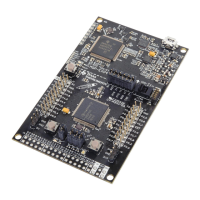Boot Loader
COMMAND_RESET
= 0x25
This command is used to tell the boot loader to reset. This is
used after downloading a new image to the microcontroller to
cause the new application to start from a reset. The normal boot
sequence occurs and the image runs as if from a hardware reset.
It can also be used to reset the boot loader if a critical error
occurs and the host device wants to restart communication with
the boot loader.
The boot loader responds with an ACK signal to the host device
before actually executing the software reset on the microcon-
troller running the boot loader. This informs the updater appli-
cation that the command was received successfully and the part
will be reset.
The format of the command is as follows:
uint8_t pui8Command[1];
pui8Command[0] = COMMAND_RESET;
The definitions for these commands are provided as part of the Tiva Peripheral Driver Library, in
boot_loader/bl_commands.h.
2.3 USB Interface
The USB boot loader allows programming the flash over USB using the standard USB DFU update
method. To use the USB boot loader, the system running the boot loader must be capable of acting
as a USB device and have the proper USB B or USB AB connector. The boot loader does not sup-
port firmware update of systems which operate solely as USB hosts. The USB update mechanism
allows the boot loader to either be called from a functioning application or from startup when no
firmware has been downloaded to the microcontroller. When the USB boot loader is called from an
application, the application can customize some of the descriptors that are used for enumeration.
This customization option is not available when the microcontroller is being programmed and there
is no application present on the microcontroller.
When the USB boot loader is invoked from a running application, the boot loader reconfigures the
USB controller to publish the required descriptor set for a Device Firmware Upgrade (DFU) class
device and merge in any custom values that the application provides. Before calling the boot loader
from an application, the main application is responsible for the following: enable the main PLL and
configure it as the system clock, enable the USB PLL, enable the USB controller, and enable the
USB D+ and D- pins on the microcontroller. If the main application is already acting as a USB
device, then the application must remove the device from the bus by calling the DriverLib function
ROM_USBDevDisconnect() prior to entering the boot loader.
2.3.1 USB Device Firmware Upgrade Overview
The USB boot loader enumerates as a Device Firmware Upgrade (DFU) class device.
This standard device class specifies a set of class-specific requests and a state ma-
chine that can be used to download and flash firmware images to a device and, op-
12 April 8, 2013
